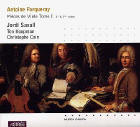Texte paru dans: / Appeared in: |
|
| Appréciation d'ensemble / Overall evaluation : | |
|
Reviewer: Julie
Anne Sadie These performances by Jordi Savall do surprise one. To his palette of bright and exotic colours he has added delicate pastels and melancholy purply hues. The much performed A minor Allemande of the First Suite, usually rendered with much ferocity and intensity, here conveys a feeling of poignancy and even nostalgia. The music is marked noblement avec sentiment ; Savall has chosen to wear his nobility lightly and in doing so creditably makes us think differently about the piece. Likewise, "La Portugaise" of the same suite is more understated and melancholy than one is used to. Even more unexpected and delectable are the delicate interpretations of "La Mandoline" and "La Dubreuil" of the Second Suite.
It is interesting to speculate about the extent to which the instrument on which he chose to record a characteristically sweet and even-toned Barak Norman of 1697, influenced the character of these performances. I would not have thought it the right Instrument for a repertory belonging to the last decadent flowering of French baroque music. Forqueray's music is usually played on French or German eighteenth-century instruments, set up to favour a penetrating top register and booming bass (not altogether unlike the harpsichords of the period). This lovely little instrument affords great facility because of its responsiveness -used to good advantage in "La Forqueray" (Suite No. I), "La Bouron" and " La Leclair" (both from Suite No. 2) - but lacks the fire seemingly inherent in the music. Still,. Savall has taken advantage of its qualities, particularly In the seductive "La Cottin " , the hypnotic "La Bellemont" and the unfailingly moving "La Couperin" (all from Suite No. I).
As before, so
here I am inclined to take issue with elements of Savall's interpretation of the
French style. Fundamental to the rendition of French dance music, however
stylized, is a sense of pulse. Savall constantly tinkers with his chosen tempo,
alternatively slowing and speeding, and superimposing enflés upon written
ornaments that serve only to distort both the pulse and the ornaments' original
intention. Nor is he content to play simple phrases . Sometimes, as with the
divisions in the repeated sections of "La Mandoline", he succeeds admirably;
occasionally, as in one eight-bar phrase of the Chaconne of the Second Suite,
his added figuration is excruciating. Clearly he is intent upon impressing his
distinctive stamp upon everything he plays. In that he makes us think again -
and marvel anew at the music - it may be a good thing, but in several particular
regards these should not be considered definitive performances. |
|
|
|
|
|
Cliquez l'un ou l'autre
bouton pour découvrir bien d'autres critiques de CD |
|




